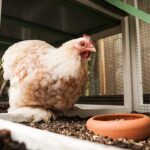Besides offering protection for the birds, chicken coops don’t have to be boring. A creative design that makes it easy to raise and care for the birds can help further stir the idea of growing your chicken numbers. Without forgetting that effective coop designs will help promote birds’ health. This is in addition to providing enough ventilation for the removal of harmful gas, excessive heat and moisture, dust, and shielding from excessive cold and predators.
That said, your kienyeji chicken coop design should encourage feeding, disease and pest control, breeding, and even provide extra comfort to the birds. It should also suit your rearing style, be it free-range, pastured rearing, deep litter rearing, or caged house rearing. Do not forget to select an ideal location with trees to break tough winds and regulate temperatures when it is too hot. Furthermore, it doesn’t have to be complicated. It should be easy and quick to scale when the crowds grow, especially if you are into commercial poultry rearing.
Off to basic poultry coop construction ideas for your kienyeji chicken. Here are some design ideas for those constructing a chicken coop. these designs can also suit other breeds, not just the kienyeji ones, and are suitable for small-scale and large-scale kienyeji chicken farming.
- Foraging
- Nesting
- Dust bathing
- Perches
1. Foraging
This design is most suitable for semi-free range kienyeji poultry rearing. The house is constructed in a way that leaves enough space or special spaces where the chicken can be found and reach green forage. It is considerable for any type of rearing because 20% of Chicken feeds come from foraging and chicken, especially the kienyeji types, enjoy pecking around to find worms and other feeds. The house can have a large foraging section for all birds where the floor is open to the ground with grass. This is in addition to other sections where the chicken can go for extra shelter when the weather is harsh.
Using forage also helps to save considerable costs of feeds and entire poultry farming exercise. Feed costs constitute 70% of poultry farming costs.
Like all other designs, any material can be used to construct the shelter as long as you keep cooping construction standards.
2. Nesting
Another idea is to include secluded nesting boxes where hens like to lay their eggs. The nests can be included in addition to the large foraging area for all birds. These boxes also make it easy to collect eggs from the house.
3. Dust bathing
Chickens like bathing in dust. For this reason, the chicken house or coop should provide for this. Chicken use dust bathing as a natural way to keep off and wade off parasites. The dust bathing areas can be part of a large coop and the floor is obviously left open to ground soil.
4. Perches
Perches allow the chicken to roost on at night and during the day. Perching is also a way for the chicken to wade off boredom. Remember, boredom can encourage bad behavior like cannibalism. Perching also prevents external parasite infestation or reduces exposure to external parasites.
Read More on Chicken Housing https://kienyeji.org/index.php/category/kienyeji-chicken-housing/
Order KIENYEJI CHICKEN HOUSING MANUAL https://kienyejichicken.com/kienyeji_housing_manual.php


